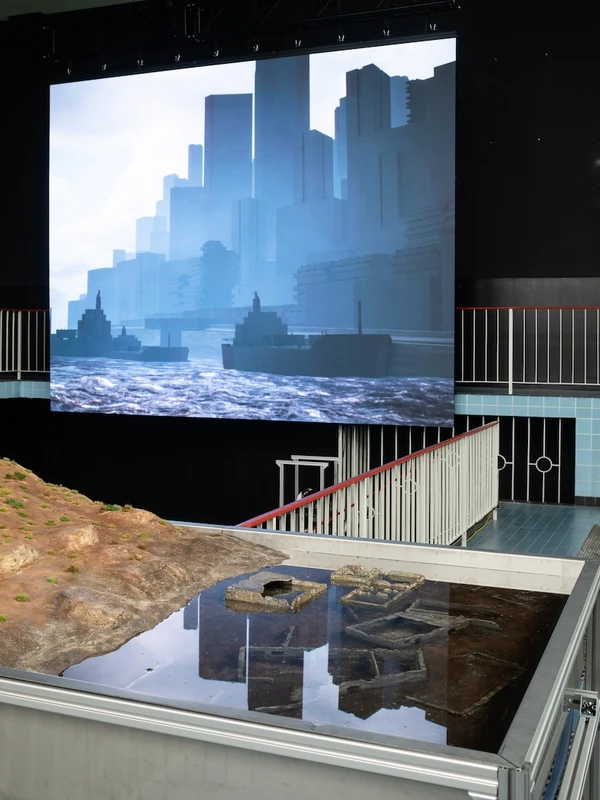dream sequence
6 Jul-27 Oct 2024


In Yuri Pattison’s dream sequence installation, water assumes a central role in its metaphorical dimension, but also as a carrier of measurable data. Sited in the mid-century era Pump House No. 2, Pattison has integrated complex digital and online networks among the now obsolete mechanical systems that once controlled the flow of water in and out of the graving docks.
The central component of the exhibition is a generative video on a monumental-scale LED wall mounted within the architecture of hoists, gears, pipes and pumps. The video takes a narrative cinematic journey that follows the course of an imagined river from its source as a forest stream, along natural tributaries, through an industrial plant, a derelict post-industrial landscape, and a harbour metropolis at the ocean’s edge, before concluding with a view of a sunset over an endless horizon. It is rendered within a game engine amalgamation of several global rivers including the Liffey, Thames, Pearl River Delta, Jordan, and Ruhr (where a previous iteration of the work was exhibited in 2023), amongst others. Specific landmarks of Dublin’s industrial environment, such as the distinctive Poolbeg Stacks, are reinterpreted and warped as part of the game engine sequence.
Significant aesthetic, auditory and structural elements of the installation are directly influenced by changes in localised live external data from the ‘real world’ (atmospheric conditions, air and water quality). Data is drawn from monitors in Pump House No. 2 and elsewhere in Dublin Port, and transmitted via a processing system to deliver context-specific image/data variations. The result is a mutable and continuously fluctuating sequence of imagery, sound and movement throughout the exhibition. The utilisation of live data directly and continually ties the work to the current moment. Conditions such as drought, flooding, global heating, and pollution affect and are reflected in the work in real-time.
dream sequence utilises the enduring symbolism of rivers to describe the passage of time across societies, throughout history. Visually the video explores the aesthetic mechanisms of the dream sequence trope in popular culture, as it seamlessly loops in a form of cyclical storytelling, with heightened atmospheric, colour and lighting effects. In its implementation of external live data processing, the work also simulates the subconscious somatic, and psychological dream state, as well as how environmental shifts can influence the perception of reality. When considered outside of bodily experience, dream sequence is an analogy of virtual metaverses and a transgressive escape from a hostile world.
The video’s score is ‘played live’ by a Disklavier (MIDI-controlled player piano). The instrumental soundscape conjures further associations with alternative realities and cinema, and through its self-playing mechanism, echoes the haunting quality of the disused machinery in Pump House No. 2. Through a detailed adaptive composition system, the score is unique each time it is experienced as notes are added and removed dependent on local environmental data monitoring.
A physical scale model of a landscape also draws live data to raise and lower the water level in a floodplain, periodically submerging a group of miniature ruined buildings. This analogy of global warming demonstrates the immediate effects of the otherwise abstract implications of the climate crisis. Concealed within the model’s buildings are mudlarking finds, collected by the artist along the River Thames during the initial months of the Covid-19 lockdowns in London. This mode of everyday archaeology compresses time between the past and present, during a period of timelessness, when the effects of climate change were slowed by the stalling of global production infrastructure and consumer air travel.
clock speed (the no more) is installed near the entrance of the Pump House No. 2, as a proxy factory clock, an omnipresent signal of the authority of time in the workplace. Using a now obsolete artificial intelligence image generation tool, BigGAN, this video displays a sequence of clock faces slowly morphing into other images generated from pre-defined image categories. These categories were compiled by researchers at DeepMind (Alphabet/Google) as a representation of the wider world. The artist found they contained a large number of military references amongst those of oil extraction, shipping, etc. The work can be seen in parallel to violent accelerated progress, where automated systems replace human labour and through this usurp human-centric concepts of time.
In July and August, another new work transmits a live stream from the upper storeys of the former Odlums grain silos adjacent to the Pumphouse site back to the gallery window in Temple Bar. The gallery screen displays a low-res, abstracted view of the Dublin Bay horizon, providing a counterpoint to the rendered game engine video in Pump House No. 2. The visuals are overlaid with a time-accurate digital clock interface displaying Dublin Mean Time, the official time in Ireland between 1880 and 1916. When Ireland began to observe Greenwich Mean Time, it effectively lost 25 minutes 21 seconds from its future history.
Horizons and sunsets have become a consistent motif throughout Pattison’s practice, signifying a recurring metaphorical end to the unfolding of time. Throughout dream sequence, the seascape also determines the resolution of a river’s journey, and the point where this particular network joins a larger, more complex system of connection on a global scale.
Yuri Pattison’s recent solo exhibitions include: mother’s tankstation Dublin and London (2022, 2019, 2017, 2016); The Douglas Hyde Gallery, Dublin (2020); Kunsthalle Sankt Gallen (2017); Chisenhale Gallery, London (2016). Pattison’s work has been shown at Irish Museum of Modern Art, Dublin; Tate Britain, London; Tate Liverpool; Louisiana Museum of Modern Art, Humelbæk; MUDAM, Luxembourg; MUSEION, Bolzano; Seoul Mediacity Biennale; Tai Kwun Contemporary, Hong Kong; ICA, Miami. dream sequence is commissioned by Urbane Künste Ruhr (UKR), in collaboration with TBG+S. It was first exhibited as part of the UKR exhibition Ruhr Ding: Schlaf in 2023, and supported by an Arts Council Project Award.